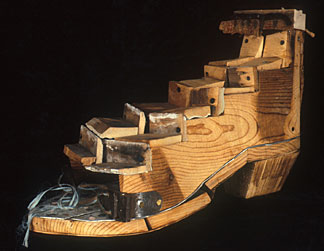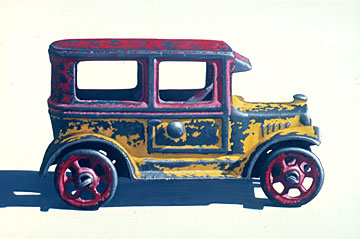 |
Judy Richardson
Shoe House - 1998
wood, metal, hair
13 x 20 x 9 inches (33.02 x 50.8 x 22.86 cm
Judy Richardson This work is composed of the forms and textures of a world that speaks of the wonders of everyday. Sculptures are built, bound, wrapped or sewn with familiar materials like rope, wire and shoe leather. Ideas about structure come from the constructions of humans and animals. As if the only materials available to the artist are the things that already exist, there are stairs made of chairs, shoes, baskets and clothes. A giant rope is twisted and braided from cords, hoses and straps. There are forms found in nature like hives and nests fabricated from metal and plastic. These are objects that refer to function, an animal house or a giant fishing net that might be found in gardens, on farms, tucked away in Casbas and attics. Judy Richardson, December 2000
 |
Shimon
Okshteyn
Bell - 2000
graphite and pencil on canvas
115 x 92 inches (292.1 x 233.68 cm)
Shimon Okshteyn Shimon Okshteyn is undistracted. His work, his life, is focussed so obsessively, so tediously, so frighteningly, that it is almost impossible to see what he is doing. When you see his studio you may at first conclude that he is sitting surrounded by huge photographs, then you notice that his only materials are some pencils, no cameras, no lens, no film. Then you decide he is a madman. To take an object, mechanical perhaps, manufactured certainly, and then to render it in this fashion is such an extreme act, so chaotic apparently in intention that you fear for the creator. Your question of How? Is followed consistently by Why? Why indeed? The answer, maybe, is that Shimon wants to capture the essence, the form and vibration of an object. He wants to give dignity to the mass produced. To use this facility for this task gives nobility to the humblest safety pin or most intricate millinery. A safety pin is a wonder of this century, and Okshteyn is driven to reveal that. He wants, as he says himself, to make icons and for him these icons are all around us and unrecognized. His project is a Pop one - after all Warhol made the soup can an icon - but Okshteyn brings to his work a powerful sense of alienation and a genuinely fin de siécle character of lament and celebration. A sadness for the passing and glorious affirmation of human skill, drive and application, in his slow agonizing creations. This is a new kind of Pop Art. Engaging, shocking and baffling. Okshteyn's purpose is to focus the world around him through an intense engagement with these objects and let nothing distract him in their contemplation. He is after all pursuing a headlong, relentless and probably impossible task, but in this battle to represent, to illuminate this past, this history, his being undistracted is a gift to us all. From Shimon Okshteyn November 10, 1999 - January 7, 2000 Robert Sandelson Gallery, London, England
 |
John Tully Geyer
Taxi - 1997
oil on canvas
30 x 45 inches (76.2 x 114.3 cm
John Tully Geyer The toy car pictures evoke memories of childhood. Some of the cars were played with by my sons and others were borrowed from friends. I enjoy painting old toys because of the wonderful shapes, colors and detail. I cross light when I photograph them to emphasize the chipped paint and dents. I paint in oil on canvas. John Tully Geyer, December 2000
 |
Suzanne
H. Ulrich
no.646 9.19.2000 - 2000
cut, torn, painted and pasted papers
4.75 x 9.5 inches (12.06 x 24.13 cm)
Suzanne H. Ulrich Inspired by my French correspondence since childhood I began this suite of collage works in early 1997. These collages include sections of old postcards, lead bands from the necks of wine bottles, magazine bindings and scraps and stamps from old letters. The bits and pieces of cut, torn and pasted papers and gouache painted envelopes are worked and reworked. With an economy of means they become organized at some point and resolve themselves with restraint and calm. These are small meditative collages of irregular bands of colors, shapes, typography, scoring and subtle textures. Some are quiet, some are forceful, some complex and some are spare and minimalist. This is a visual language of developed concepts and meanings that exist beyond verbal expression. Suzanne H. Ulrich, December 2000
 |
Tom
Chambers
Pueblo Fire - 1997
digital photomontage
17.5 x 12.5 inches (44.45 x 31.75 cm)
Tom Chambers Technological advances have freed Western culture from focusing on lower-level needs, such as finding food and shelter. With the use of technology, humanity becomes more outward-focused and object based, while losing its spirituality. Natural wisdom and intuition are masked. Because children are innately in synch with their spirit, finding their way through an object-based world can be disconcerting. Sometimes their natural wisdom leads them in one direction, while technological society leads them in another. As a result, children often abandon their spiritual road map. In my work, children and animals are used symbolically, creating a surreal landscape which depicts human vulnerability. Using layers of symbolic opposites, such as animal/human, spiritual/sensual and natural/man-made, I juxtapose conflicting images to create an improbable, but imaginable view of the world. Working with photos I have taken throughout the United States and Mexico, I create digital photomontages printed onto archival paper. Digital photography provides an innovative approach for generating images. Ironically, the technological tools which have degraded humanity, also allow me to portray the tension resulting from technological change. Tom Chambers, December 2000
This web site was designed and created by REDRUM DESIGNS ©2000 OK HARRIS All Rights Reserved